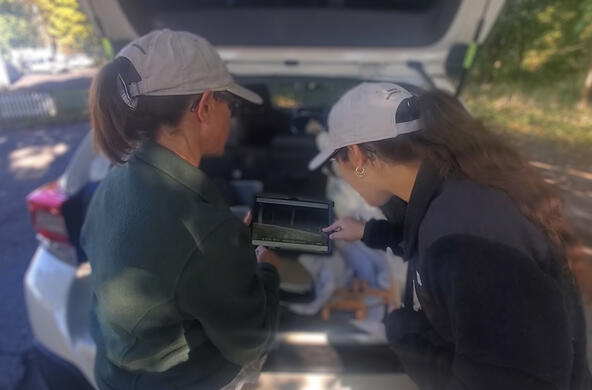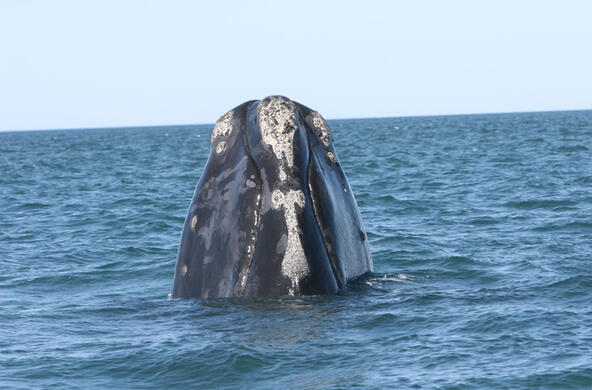An antidepressant commonly detected in waterways could change crayfish behavior in ways that could harm them and their environment.
Antidepressants meant to treat humans can also affect aquatic animals when those drugs enter waterways.
In a paper published today in the journal Ecosphere, researchers found that crayfish exposed to moderate levels of the antidepressant citalopram, commonly sold as Celexa, spent significantly more time foraging for food and less time in hiding. The behavior could make the crayfish more vulnerable to predators, and their altered behavior could, over time, have other effects on stream ecosystems.
The study was performed in a research center in a waterway that mimicked the natural environment, and crayfish were exposed to drug levels found in real-world settings.
“It was surprising to see the extent to which the behavior changed,” says study co-author Lindsey Reisinger, a freshwater ecologist at the University of Florida. “It was pretty dramatic.”
Crayfish exposed to the antidepressant, for example, were almost twice as quick to peek out from and emerge from their shelters in search of food, compared to non-exposed animals.
The study, the first to examine crayfish and antidepressants in a naturalistic setting, raises concerning questions about the extent and impact of this type of pharmaceutical pollution, says co-author A.J. Reisinger, who worked on the study as a post-doc at the Cary Institute for Ecosystem Studies and is now a freshwater biogeochemist at the University of Florida. (The two researchers are married.)
Drugs in the water
Citalopram is a selective serotonin reuptake inhibitor (SSRI), a broad class of antidepressants that are among the most widely prescribed drugs in the world. In 2018, nearly one in eight people in the U.S. reported taking an SSRI. These drugs are designed to alter human brain chemistry by increasing levels of the neurotransmitter serotonin, which helps regulate mood, happiness, and anxiety. But they can also affect the neurochemistry of many nonhuman animals, especially those that live in water.
Drugs get into waterways through several different pathways. We swallow pills but still excrete trace amounts of them in urine or feces. The compounds get into the environment through leaky septic systems or from wastewater treatment plants, which weren’t designed to remove them. People often dump unused pills down drains; drug manufacturers also discharge this pollution.
Marine and freshwater organisms may be exposed to mixtures of many different drugs. These compounds often occur at low levels, but they can have additive effects, says Portsmouth University toxicologist Alex Ford, who wasn’t involved in the paper. Previous research has shown that SSRIs can reduce “anxiety-like” behaviors and sometimes increase both aggression and locomotion in a range of aquatic animals.
The Reisingers and colleagues designed their study to understand how crayfish respond to these drugs. For two weeks, they exposed crayfish to 500 nanograms per liter of citalopram in their artificial stream, which contained rocks and vegetation where crayfish could hide.
As part of the study, they tested how quickly both control and SSRI-exposed crayfish reacted to the scent of food. The latter group peeked out from their shelters twice as quickly, emerged nearly one minute earlier, and spent 400 percent more time in the food-section of the test apparatus.
Though the scientists did not introduce predators to their setup, they hypothesized that crayfish acting this way would be more likely to be eaten by predators, which in the wild include raccoons, foxes, large fishes, and birds.
Crayfish are one of the dominant consumers of stream leaf litter and aquatic insects, and so any impact on their behavior could have wide-ranging ecological implications, Lindsey says. In this paper, the researchers note that during the citalopram exposure, levels of algae and organic compounds in the water rose. They hypothesized that the crayfish were eating and therefore excreting more nutrients, which promoted algal growth, or that their increased movement kept algae and nutrients from settling on the “stream” bottom.
“The authors certainly found changes in behavior,” Ford says, “and any changes to ‘normal’ behavior could mean organisms are spending less time feeding and finding mates,” evading predators, or simply growing.
Dose makes the poison
It’s important to note that this study was conducted in a laboratory, and the team did not include some real-world variables. Still, it exposed crayfish to levels that could be encountered in their streams and ponds and certainly to levels that occur immediately downstream from some sewage treatment facilities. One 2009 study found citalopram at 500 nanograms per liter about 20 miles downstream from a wastewater treatment plant in India—and concentrations of 76,000 nanograms per liter in an area with several pharmaceutical plants.
Antidepressants can contaminate animals through various exposure pathways. Crayfish absorb the chemicals through their gills and the detritus they eat. Meanwhile, larger predators that consume crayfish—or other small animals that have absorbed antidepressants—will also accumulate these contaminants. One recent study conducted in Australia calculated that brown trout and platypuses, by eating animals exposed to antidepressants, may daily consume up to half of a human’s therapeutic dose of those drugs. The same paper found that SSRIs comprised a full one percent of the body mass of a riparian spider, a voracious consumer of arthropods.
“That’s a lot of chemicals in your body,” A.J. Reisinger says.
Responsible management
To protect the environment from unused drugs, bring your unwanted pills to a pharmacy or a drug take-back event. If that’s not possible, take the pills from their container and mix them with something distasteful and absorbent, like coffee grounds, and place them in the trash.
“You can do your part to reduce pharmaceutical pollution by properly disposing of your medications,” A.J. Reisinger says. “Don’t ever flush anything down the drain.”
Trevor Hamilton, a researcher at MacEwan University in Edmonton, Canada, says the new study, with which he was not involved, is more relevant now than ever. In the United States, the prevalence of depression symptoms was three times higher during the pandemic than before.
This spike in antidepressant use will increase concentrations of the drugs in wastewater effluent “to the highest levels ever,” Hamilton predicts. “This will create a significant challenge for many organisms with neurochemistry that is affected by these modulators.”






